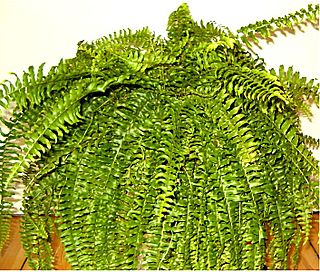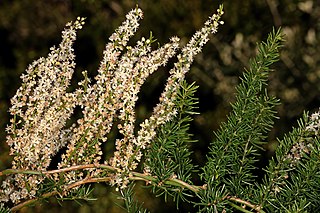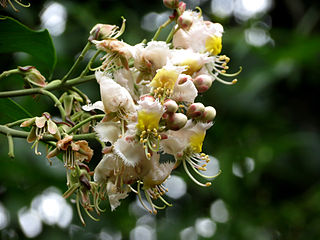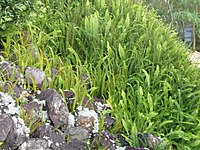
An epiphyte is a plant or plant-like organism that grows on the surface of another plant and derives its moisture and nutrients from the air, rain, water or from debris accumulating around it. The plants on which epiphytes grow are called phorophytes. Epiphytes take part in nutrient cycles and add to both the diversity and biomass of the ecosystem in which they occur, like any other organism. They are an important source of food for many species. Typically, the older parts of a plant will have more epiphytes growing on them. Epiphytes differ from parasites in that they grow on other plants for physical support and do not necessarily affect the host negatively. An organism that grows on another organism that is not a plant may be called an epibiont. Epiphytes are usually found in the temperate zone or in the tropics. Epiphyte species make good houseplants due to their minimal water and soil requirements. Epiphytes provide a rich and diverse habitat for other organisms including animals, fungi, bacteria, and myxomycetes.

The ferns are a group of vascular plants that reproduce via spores and have neither seeds nor flowers. They differ from mosses by being vascular, i.e., having specialized tissues that conduct water and nutrients and in having life cycles in which the branched sporophyte is the dominant phase.

A number of introduced species, some of which have become invasive species, have been added to New Zealand's native flora and fauna. Both deliberate and accidental introductions have been made from the time of the first human settlement, with several waves of Polynesian people at some time before the year 1300, followed by Europeans after 1769.

Nephrolepis exaltata, known as the sword fern or Boston fern, is a species of fern in the family Lomariopsidaceae. It is native to the Americas. This evergreen plant can reach as high as 40–90 centimetres (16–35 in), and in extreme cases up to 1.5 metres. It is also known as the Boston sword fern, wild Boston fern, Boston blue bell fern, tuber ladder fern, or fishbone fern.

Schinus terebinthifolia is a species of flowering plant in the cashew family, Anacardiaceae, that is native to subtropical and tropical South America. Common names include Brazilian peppertree, aroeira, rose pepper, broadleaved pepper tree, wilelaiki, Christmasberry tree and Florida holly. The species name has been very commonly misspelled as ‘terebinthifolius’.

Anredera is a genus of plants native to Latin America, the West Indies, Texas, and Florida. Some are naturalized in other regions. Most of them evergreen vines of dry scrubland and thickets. Members of the genus are commonly known as Madeira vines. At least one species, A. cordifolia bears edible roots or tubers and leaves similar to those of Basella alba. The same species has become an invasive plant in many tropical and subtropical regions outside its natural range.

Nephrolepis is a genus of about 30 species of ferns. It is the only genus in the family Nephrolepidaceae, placed in the suborder Aspleniineae of the order Polypodiales in the Pteridophyte Phylogeny Group classification of 2016. The genus is commonly referred to as macho ferns or Boston ferns. The fronds are long and narrow, and once-pinnate, in the case of one Bornean species reaching thirty feet in length.

Anredera cordifolia, commonly known as the Madeira vine or mignonette vine, is a South American species of ornamental succulent vine of the family Basellaceae. The combination of fleshy leaves and thick aerial tubers makes this a very heavy vine. It smothers trees and other vegetation it grows on and can easily break branches and bring down entire trees on its own. Other names include lamb's tail and potato vine.

Asparagus aethiopicus, Sprenger's asparagus, is a plant native to the Cape Provinces and the Northern Provinces of South Africa. Often used as an ornamental plant, it is considered an invasive weed in many locations. Asparagus fern, asparagus grass and foxtail fern are common names; however, it is unrelated to true ferns. A. aethiopicus has been confused with A. densiflorus, now regarded as a separate species, so that information about A. aethiopicus will often be found under the name A. densiflorus.

Psilotum nudum, the whisk fern, is a fernlike plant. Like the other species in the order Psilotales, it lacks roots.

Ipomoea indica is a species of flowering plant in the family Convolvulaceae, known by several common names, including blue morning glory, oceanblue morning glory, koali awa, and blue dawn flower. It bears heart-shaped or three-lobed leaves and purple or blue funnel-shaped flowers 6–8 cm (2–3 in) in diameter, from spring to autumn. The flowers produced by the plant are hermaphroditic. This plant has gained the Royal Horticultural Society's Award of Garden Merit.

Hiptage benghalensis, often simply called hiptage, is a perennial, evergreen liana native to India, Southeast Asia, Taiwan, and the Philippines. Its habitat is variable and prefers climates ranging from warm temperate to tropical. In Hawaii, where H. benghalensis is considered a weed, as it is in Australia, Mauritius and Réunion, it grows from sea level to 1,000 m (3,281 ft). H. benghalensis is cultivated for its white-pink scented flowers.
Button fern is a common name for several plants and may refer to:
Tuber ladder fern is a common name for several plants and may refer to:

Anchistea is a genus of leptosporangiate ferns in the family Blechnaceae. It has only one species, Anchistea virginica the Virginia chain fern, which has long creeping, scaly, underground stems or rhizomes giving rise to tall widely separated, deciduous, single leaves. In contrast, the leaves of Osmundastrum cinnamomeum, which can be mistaken for A. virginica, grow in a group from a crown. Also in contrast to O. cinnamomeum the leaves are monomorphic without distinct fertile fronds. The lower petiole or stipe is dark purple to black, shiny and swollen, the upper rachis is dull green. The leaf blade is green and lanceolate, composed of 12 to 23 paired, alternate pinnatifid pinnae. The pinnae are subdivided into 15 to 20 paired segments that are ovate to oblong. The lower rachis is naked for about half its length. The sori or spore-producing bodies are found on the underside of the pinnae and are long and form a double row which outlines the major veins of the pinnae. In common with all ferns, A. virginica exhibits a gametophyte stage in its life cycle and develops a haploid reproductive prothallus as an independent plant. The spores are produced in red-brown sori which line the spaces (areolae) between the costa and costules. Further photographs can be found at the Connecticut Botanical Society and Ontario Ferns websites.

Stachys floridana is a species of betony in the mint family, Lamiaceae. It is native to the United States, where its true native range is probably limited to Florida, but today it is known throughout the Southeast as an introduced species and common weed. It occurs as far west as Texas, and it has been recorded in California. Its common names include Florida betony, Florida hedgenettle, and rattlesnake weed. It has been called wild artichoke, but it is not closely related to artichoke. The plant was the Florida Department of Agriculture's "Weed of the Month" for February 2010.

Asplenium appendiculatum, ground spleenwort, is a common native fern to Australia and New Zealand. It usually grows in cool damp conditions, among rocks, on logs or as an epiphyte.

Oenanthe aquatica, fine-leaved water-dropwort, is an aquatic flowering plant in the carrot family. It is widely distributed from the Atlantic coast of Europe to central Asia.

Callisia repens, also known as creeping inchplant or turtle vine, is a succulent creeping plant from the family Commelinaceae. This species comes from Central and South America.
























